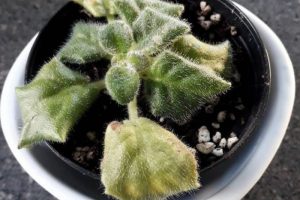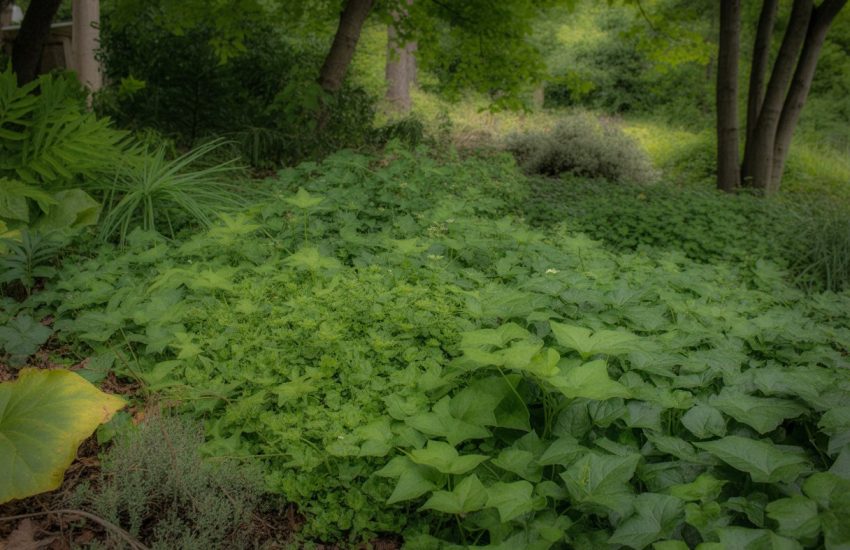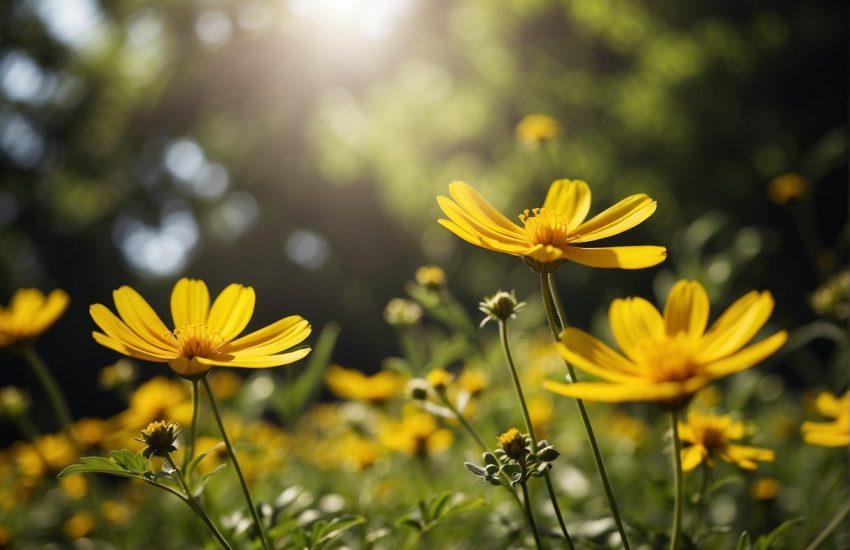African Violet Leaves Turning Yellow
Most houseplants are sweet, elegant, and always well-dressed. African violets are no exception. Their stalks stand tall and straight; their leaves are bright and neat, their flowers are like jewels in a crown. But when those sweet violet leaves turn yellow, it might signal a problem that needs attention.
Water
The watering needs of African violets vary. Most African violets need to be watered when the soil is dry to the touch. If you can’t remember when you last watered your violet, try sticking your finger into the soil up to the first knuckle (about one inch). If it feels moist, then your plant doesn’t need water yet.
If you are in doubt about how much water your violet needs, use a moisture meter or a soil probe to check the moisture level in the soil near the plant’s roots. The probe should be inserted at least half an inch deep into the soil. If there is less than 1/2″ of water present, then it’s time to water your plant.

Over watering
Over watering is the most common cause of yellowing leaves on houseplants. African violets are very sensitive to overwatering, as are most plants that belong to the family Gesneriaceae (the African violet is in this family).
If your plant’s leaves start turning yellow and dropping from the plant, it’s probably because you’re watering it too much. Watering a houseplant too much can cause root rot or stem rot, which leads to yellowing leaves and leaf drop.
Under watering
When the plant does not receive enough water, its roots will begin to die off. This can cause the plant’s leaves to turn yellow and wilt. If you notice this happening, it’s time to increase the amount of water you give your plant.
If you have several plants in one pot, they may compete with each other for water, leading to underwatering issues among those plants. To prevent this from happening, place a drip tray underneath your pots so that excess water drains away from the soil surface instead of collecting on top of it where competing plants in the same pot could absorb it.
Too Much or Too Little Fertilizer
The leaves of African violets change color for a variety of reasons. The leaves generally turn yellow because of too much or too little fertilizer.
Over-Fertilizing
Too much fertilizer can cause leaf burn, which can lead to leaf drop and discoloration. If you’re giving your African violet too much fertilizer, the leaves will turn yellow and brown in spots, with edges that may curl upward slightly. When this happens, it’s time to cut back on the amount of fertilizer you’re giving your plants. You may also see dark brown or black roots at the tips and base of the plant’s stem.
Under-Fertilizing
If you aren’t fertilizing your plant enough, its leaves may turn yellow or pale green as they grow older. The veins will show through more than usual and may appear as white streaks on top of the leaf’s surface. The tips of new growths may die off as well as older foliage when under-fertilized. Under-fertilization is especially common in older African violet plants because their root systems decrease over time, making it harder for them to absorb nutrients from the soil.
The main nutrients an African Violet should absorb to stay healthy
The main nutrients an African Violet should absorb to stay healthy are nitrogen, phosphorus, and potassium. These three elements are present in all fertilizers, but the composition of each type is different.
Nitrogen is needed for leaf growth and overall plant health. Plants that have too little nitrogen will have smaller leaves and fewer flowers. They may also become pale green or yellowish. If your plant is turning pale green, check the package to see if it needs more nitrogen.
Phosphorus is another essential element that helps keep your plant healthy. It helps strengthen cell walls and root hairs, making them better able to absorb water and nutrients from the soil. It also helps with photosynthesis, which is how plants convert light into energy they can use for growth and reproduction. Phosphorus deficiencies usually show up as stunted growth or brown spots on leaves.
Potassium helps regulate how much water enters and leaves your plant’s cells through its stomata (tiny openings), allowing them to control their transpiration rate (water loss). Potassium deficiencies can cause wilting or leaf scorch due to excessive transpiration.
Poor Drainage
Poor drainage is a common problem with African violets. The soil in an African violet pot should be kept evenly moist but not wet. A common problem is poor drainage of the potting mix. This can cause the roots to rot and damage or kill the plant.
Poor drainage occurs when water cannot drain through the potting mix fast enough to prevent it from becoming saturated with water. This can occur because the potting mix does not have enough air space or because there are excessive amounts of clay in the potting mix.
If there is poor drainage in your pot, you may notice that some of your leaves begin to turn yellow or brown before others do. This happens because some parts of the plant still get enough oxygen from the air, while others do not get enough oxygen due to being underwater for too long. This causes some parts of your plant to die while other parts are still alive and growing normally.
Examples of soils that have good drainage
The soil you choose to grow African Violets needs to have good drainage. Here are some examples of soils that have good drainage:
Peat
Peat is a type of soil that is made from decomposed plant material. It is used in horticulture as a growing medium for many plants, including African Violets. The peat that is used for African Violets should be well-drained and aerated so that it will allow oxygen to pass through it. It should also be lightweight so that it can easily be moved around the house if needed.
Coir
Coir (pronounced quire) is made from coconut husks, which are a byproduct of making coconut oil. Coir is a porous material that holds moisture well but has excellent drainage properties, making it an ideal growing medium for African Violets. Coir tends to be a little more expensive than peat moss, but not by much.
Perlite
Perlite is a volcanic mineral that, when heated, expands into small, white spheres that are lightweight and porous. Perlite helps aerate the soil and lighten the weight of potting mix. Because it has so many holes, perlite has excellent drainage properties, which is why it’s often used in seed starting mixes or as a substitute for sand in other potting mixes.
Vermiculite
Vermiculite is another type of mineral with expanded properties; however, it retains more water than perlite does. It’s also lightweight and porous, but not as much as perlite. Vermiculite is often mixed with peat moss to create a well-draining potting mix for African violets.
Not Enough Light
The African violet is a succulent plant that requires bright light to thrive. Not enough light can cause your plant to lose its leaves and eventually die. If you are growing your African violet in a window and the sun is not shining directly on it, you may need to move it closer to a window where there is more direct sunlight. If your plant is in a room that doesn’t get much natural light, it will not be able to produce enough chlorophyll to create food for itself. Without food, the leaves will start turning yellow and fall off as they die from lack of nutrients. If this happens, you will need to repot the plant in order for it to continue living.
Cold Temperatures
African violets are native to Eastern Africa and are not hardy in cold temperatures. The colder it gets, the more damage it will do to your African violet. Cold air can also cause condensation on the leaves, which will make them rot. If you live in a warmer climate, you may need to bring your plant inside during winter.
Cold temperatures can be fatal for your African violet if left outside for an extended period of time. In fact, it only takes a few hours of exposure to cold weather for an African violet to become damaged or die.
The best way to protect your African violets is by bringing them inside during the cold winter months and storing them in a cool location like a basement or garage until spring arrives again.
Diseases
African violets are susceptible to a variety of diseases, including root rot, botrytis blight, and leaf spot. The symptoms of these diseases often show up as yellowing or brown spots on the leaves.
Root Rot
The most common disease affecting African violets is root rot, which attacks the plant’s roots. Root rot symptoms include wilting leaves, yellowing leaves, and stunted growth. Root rot can spread from one plant to another if you’re not careful about washing your hands after handling infected plants.
Botrytis Blight
Botrytis blight causes young leaves to turn brown and wither away, leaving only the veins behind on the leaf stem. Older leaves may turn brown as well but usually remain attached to the plant. Botrytis blight can spread rapidly through a single pot or multiple pots within 24 hours of an initial infection if left untreated.
Leaf Spot
Leaf spot appears as small brown spots on the surface of leaves that eventually turn yellow or brown with age. The spots can grow larger over time and eventually cover large portions of the leaf surface before turning black and falling off onto the soil below them.
Leaf Rusts
Leaf rusts are one of the most common causes of yellowing in African violets. The most common species of leaf rust is Cymbidium mosaic virus-1 (CyMV-1). This virus attacks young leaves and creates small yellow spots that eventually turn into larger blotches on the leaves. These spots can merge together to create entire yellowed areas on the leaves. The spots don’t usually spread beyond one leaf, but if left untreated, they can cause severe leaf loss and death of the plant.
The best way to treat this disease is by removing infected plants from your collection and destroying them immediately so that the disease doesn’t spread further through your collection. If you have an infested plant in your collection but don’t want to get rid of it because it’s valuable or sentimental, at least replace all its soil.
Pythium Soft Rot
This disease is caused by a fungus called Pythium. The spores from this fungus attach themselves to the leaves and travel down into the root system. Once in the roots, they continue to grow and multiply until they have completely taken over the entire root system. This results in poor growth and wilting of the leaves, which eventually turn yellow and fall off. There is no cure for this type of infection, but it can be prevented by providing adequate drainage and avoiding overwatering or too much humidity in your home or greenhouse.
Pests
Some of the common pests that affect African violets are:
Spider mites: Spider mites are tiny, red, spider-like creatures that cause damage to plants by sucking their sap. If your leaves become covered with webbing, you may have spider mites.
Scale: Scale is another common pest affecting African violets. These small insects look like brown or black bumps on the plant and suck plant juices from the leaves and stems. The damage they cause will appear as a loss of color in affected areas.
Whiteflies: Whiteflies are another type of sucking insect that sucks out the sap from plants, causing them to wilt and die. They can also spread disease from one plant to another through their eggs which fall off the plant onto other plants when the adult flies land on them.
Transplant shock
When you transplant a plant, it can suffer from a condition called transplant shock. This is when the plant cannot adjust to its new environment and loses many of its leaves. The leaves may turn yellow or brown and fall off within a few days of being transplanted. The roots may also be damaged or broken during the transplantation process. If this happens, it can take several weeks for the plant to recover from transplant shock and resume its normal growth patterns.
African violets are popular indoor plants that come in a variety of colors. These plants tend to do best when they are pot-bound, meaning the roots have to grow around their pot, and they cannot be over-watered. Over time, African violet leaves turning yellow is not unusual. There are, however, some actions the owners can take to correct it.


